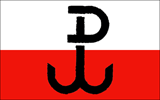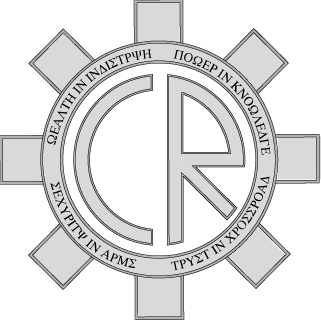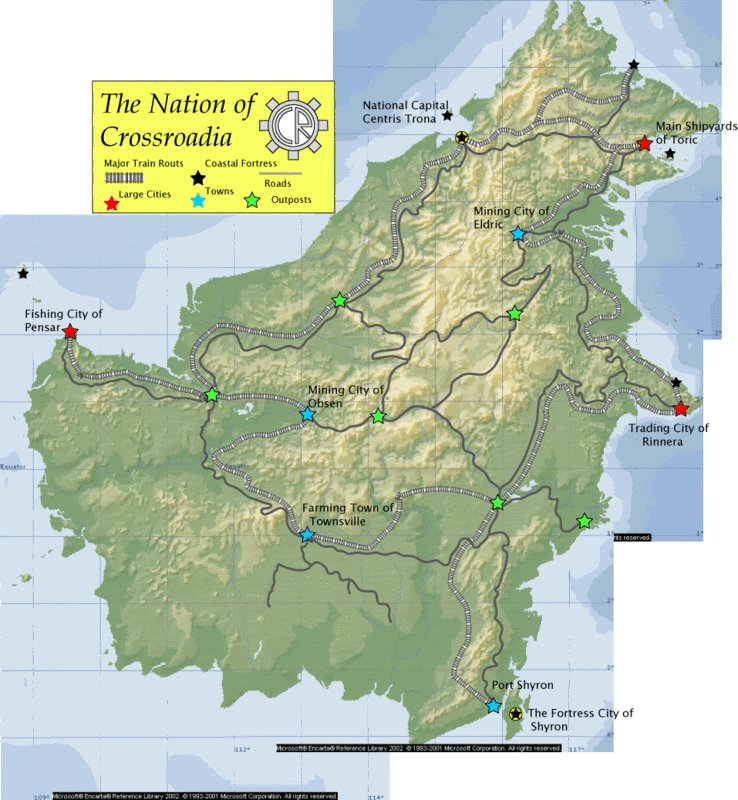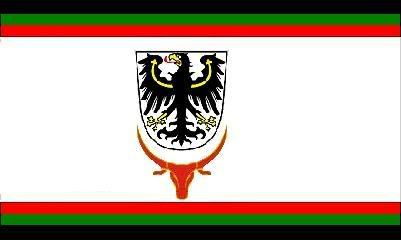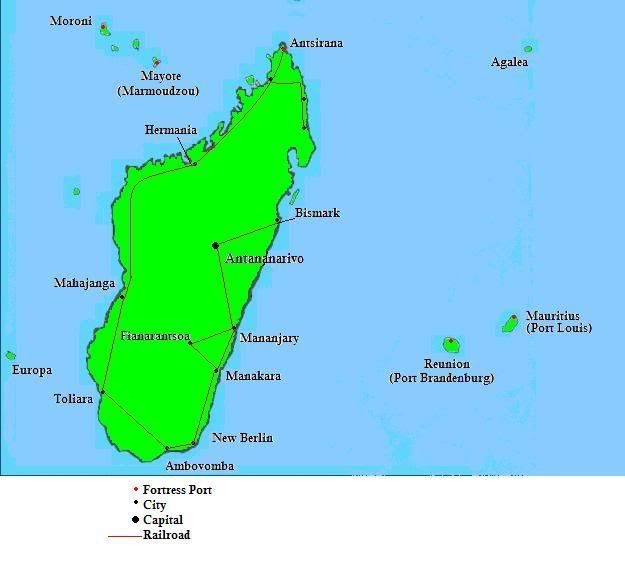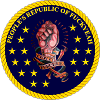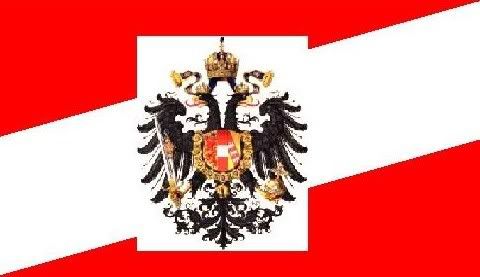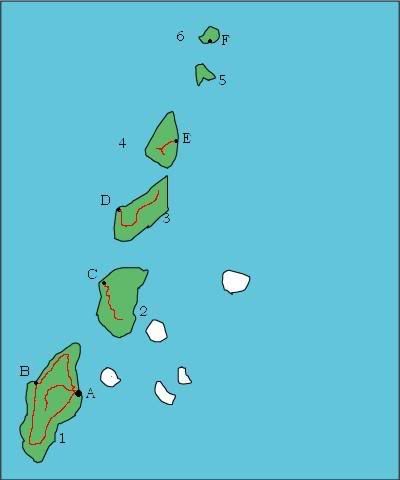Crown Colony of Northern Australia
"Oz"
 General Info:
General Info:
Located on the northern coast of Australia, this bit of the British Empire has maintained it status, all to the contrary be damned. Hence, it's still ruled by a Colonial Governor (though the current one was chosen by the prior, and it's been years since news of such should have reached Britain), and it's ships fly the Blue Ensign of the Royal Navy. It remains on good terms with the other colony on the continent of Australia.
It was settled in 1840, with the initial settlement being named Palmerston, near the northernmost tip of Australia. Later coastal settlements were Derby, in a bay on the western edge of the colony, and Karumba, located on a river at the eastern edge. Karumba is the only place on the south coast of the Gulf of Carpentaria that a coastal settlement is viable, all the rest being covered in near impassable tidal flats. Most of it's current inhabitants are refugees, either from the Potato famines, sundry other disasters, or the Great War (including Chinese immigrants from Hong Kong after the departure of British troops). The current population is 3 million.
After the usurpation of the English crown by the pretender Alfred, the colony continued to support Queen Victoria. When her restoration attempt failed, her and her heirs either were executed or went into hiding. Accordingly, though all continue to swear allegiance to the Crown, no one is quite sure who holds it.
The Colonial Governor is the 45 year-old Baron von Wulfenbach, Vice Admiral of the Blue, Lord Klaus Battenberg, formerly of Denmark aka "the Wizard". He, along with his "madboys" control the city of Palmerston, along with extensive amounts of territory along the northern coast. Madboys are so called because they are mad scientists, who possess the inborn ability to rapidly progress the field of science, but frequently possess the traits of megalomania and lack of all common sense.
The colony is fortunate in that it has been able to raise troops from the settlers, as opposed to depending on whatever troops it had from Britain before the effective end of the Empire.
It's home to a nascent shipbuilding industry headed by John I Thornycroft & Co. It's also home to a burgeoning armaments industry, including Nordenfelt Guns and Ammunition Co. Ltd. which, amongst other items, makes Lee-Metford pattern rifles for the army. Another notable refugee company is Gesellschaft zur Förderung der Luftschiffahrt which makes naval scout ships.
Geography of Oz:

Can be generally split into 3 areas, the Gulf (eastern portion), Top End(Central), and Kimberly (Western Portion). Climate is tropical, fading to semi-arid as one goes south. Major cities are Palmerston (Capital), Derby (largest town in Kimberly), Katherine(SE of Palmerston), and Karumba(the Gulf) Karumba is mostly surrounded by dense impenetrable mangrove swamps and impassable tidal flats. Derby is in a semi-arid area.
Weapons of Oz
Naval:
Guns:
12"/35 Breach-loaders (Separate loading, with powder bags)
Used on Battleships and Monitors
9.2"/31.5 Breach-loaders
1st class Cruisers
6"/40 Quick-firing (fixed complete rounds)
2nd class Cruisers
4.7"/40 Quick-firing
Secondary armament on Battleships and Cruisers
3"/40 Quick-firing aka 12pdr
Primary armament on Destroyers
37mm Hotchkiss Revolving Cannon (HRC)
Tertiary armament on Battleships and Cruisers
Secondary armament on Monitors and Destroyers
Primary on Torpedo Boats
37mm Nordenfelt-Maxim Automatic Cannon (Pom-Pom)
same usage as HRC
Torpedoes:
14" Whitehead
Primary armament on Torpedo Boats
18" Whitehead
Primary armament on Destroyers.
Army:
Siege:
6"/40 Quick-firing
4.7"/40 Quick-firing
24pdr rockets
Utilize Cordite for propulsion and warhead
Usually fired en-mass
Field:
3" Quick-firing
1.65" Mountain
37mm HRC
37mm Pom-Pom
6.5mm Maxim Machine gun
Individual:
Lee-Nordenfelt - Modified Lee-Metford Pattern rifle
fires 6.5x55mm smokeless rimless round.
Fully detachable magazine, w/ no magazine cutoff
Aperture rear sight
Martini-Nordenfelt - Modified Martini-Henry Pattern rifle
fires 6.5x55mm smokeless rimless round.
Martini-Henry re-barreled to fire the 6.5mm Nordenfelt round.
Militia Rifle
Webley Revolver
fires the highly effective .455 Webley round
top-break DA 6-round revolver
Ships of the Crown Colony of Western Australia
Victoria-class Battleship
350ft long, 70ft beam, 25ft draught
12500 ton normal displacement
250pts
Armament:
6x12" guns (2 triples fore/aft)
10x4.7" guns (Casemate, above freeboard)
8x37mm Pom-Pom (deck mount, with shield)
4x18" Torpedoes (submerged)
40pts
Armor:
15" belt, 200'long 10'high
turrets: 15" face, 10" gunhouse, 10" barbette
5" casemate
5" deck
15" conning tower
40pts
5pts torpedo
Speed:
15knots max
5000nm range at 7.5knots
20pts
20pts maneuver
Hawke-class 1st Class Cruiser
Purpose:
340ft long, 47 beam, 30ft draught
8000 ton normal displacement
160pts
Armament:
4x9.2" guns (2 twins fore/aft)
8x4.7" guns (Casemate, above freeboard)
8x37mm Pom-Pom (deck mount, with shield)
4x18" Torpedoes (submerged)
25pts
Armor:
4" belt, 340' long, 10' high
barbettes 4" shield, 7" barbette
4" casemate
4" deck
10" conning tower
15pts
5pts torpedo
Speed:
20knots max
5000nm range at 9 knots
20pts
15pts maneuver
Andromache-class 2nd Class Cruiser
30ft long, 40 beam, 20ft draught
4000 ton normal displacement
80pts
Armament:
2x6" guns (2 singles fore/aft)
6x4.7" guns (Casemate, above freeboard)
8x37mm Pom-Pom (deck mount, with shield)
4x18" Torpedoes (submerged)
15pts
Armor:
barbettes 3" shield, 5" barbette
3" casemate
3" deck
9" conning tower
10pts
2pts torpedo
Speed:
20knots max
5000nm range at 7.5 knots
8pts
5pts maneuver
Pearl-class 3rd Class Cruiser
130ft long, 35ft beam, 20ft draught
1500 ton normal displacement
30pts
Armament:
12x4.7" guns (Casemate, above freeboard)
8x37mm Pom-Pom (deck mount, with shield)
5 pts
Armor:
3" casemate
3" deck
9" conning tower
4 pts
1 pts torpedo
Speed:
15knots max
5000nm range at 7.5 knots
3pts
2pts maneuver
Havock-class Torpedo Boat Destroyer
200ft long, 25 beam, 11ft draught
500 ton normal displacement
10pts
Armament:
1x3" guns (deck mount, with shield)
3x37mm Pom-Pom (deck mount, with shield)
4x18" Torpedoes
2pts
Speed:
27knots max
2250nm range at 7.5 knots
2pts
1pts maneuver
B-class Torpedo Boat
100 ton displacement
2pt
Armament:
1x37mm Pom-Pom (deck mount, with shield)
1x6.5mm Maxim (deck mount, with shield)
4x18" Torpedoes
Speed:
1pt
ZPG-1 Naval Scout Airship
displacement: 50 tons
1 pt
Armament:
2x 6.5mm Maxim
Speed:
.5 pt
Oz Navy: 2605 pts

Command of the sea is an end in and of itself. As such, the Colonial Government has seen fit to build at strong navy.
4x Victoria - 1000pts
BatDiv 1:
HMAS Victoria
HMAS Empress of India
BatDiv 2:
HMAS Audacious
HMAS Implacable
6x Hawke - 960pts
CruRon 1:
HMAS Hawke
HMAS Blake
CruRon 2:
HMAS Theseus
HMAS Endymion
CruRon 3:
HMAS Monmouth
HMAS Apollo
2x Andromache - 160pts
CruRon 4:
HMAS Andromache
HMAS Scylla
3x Pearl - 90pts
CruRon 5:
HMAS Pearl
HMAS Phoenix
HMAS Pelorus
35x Havock - 350pts
20x B-class - 40pts
5x Mercury - 5pts
Fortifications: 207pts
4x 50pt Forts
2x protect Darwin and the shipyards, 1x Derby, 1x Kurumba
Each is armed with 5x 9.2" Naval rifles in disappearing mountings, amongst other weapons
east border forts x7
Made mostly out of sandbags faced with brick, they won't stand up to artillery fire. Maori raids over the border don't use artillery, so no problem. Holds roughly a company of infantry
Army: 1188pts 71,684 men
Some regiments took their colors to Australia after being disbanded at the end of the Great War. Others were raised from colonial citizens. One was neither disbanded and recreated, nor created from whole cloth, but rather took the last boat out of India at the fall of British India.
Dress uniforms vary in accordance with the whims of the regiment's colonel, and the history of the regiment. For example, the 95th Regiment of Foot wears green jackets. Field Uniforms are khaki fatigues with a slouch hat.
Listing of Army Units:
Household division: 300pts 8258 men
Governor's Horse Guards Regiment: 108pts
3 squadrons of 4 troops of 3 platoons of 50men = 1816 troops
Light cavalry, as such, has no cannon or machine guns.
Highly trained and professional.
Utilize a carbine version of the Lee-Nordenfelt.
Governor's Foot Guards Regiment: 96pts
4 battalions of 4 companies of 4 platoons of 50men = 3221 men
Highly trained and professional unit armed with Lee-Nordenfelts,
Horse drawn Nordenfelt-Maxims, horse-drawn 3" artillery,
and horse drawn Maxims
Sirmoor Rifles: 96pts
4 battalions of 4 companies of 4 platoons of 50men = 3221 men
Highly trained and professional unit armed with Lee-Nordenfelts,
Horse drawn Nordenfelt-Maxims, horse-drawn 3" artillery,
and horse drawn Maxims
Originally recruited from Nepal.
Central Division: 200pts 8258 men
19th Hussars: 72pts
3 squadrons of 4 troops of 3 platoons of 50men = 1816 troops
Light cavalry, as such, has no cannon or machine guns.
Decently trained and professional.
Utilize a carbine version of the Lee-Nordenfelt.
40th Regiment of Foot: 64 pts
4 battalions of 4 companies of 4 platoons of 50men = 3221 men
Decently trained and professional unit armed with Lee-Nordenfelts,
Horse drawn Nordenfelt-Maxims, horse-drawn 3" artillery,
and horse drawn Maxims
Recruits largely from immigrant Chinese
AKA Tiger Rifles
115th Regiment of Foot: 64 pts
4 battalions of 4 companies of 4 platoons of 50men = 3221 men
Decently trained and professional unit armed with Lee-Nordenfelts,
Horse drawn Nordenfelt-Maxims, horse-drawn 3" artillery,
and horse drawn Maxims
East Division: 200pts 8258 men
Lord Stratcona's Dragoons: 72pts
3 squadrons of 4 troops of 3 platoons of 50men = 1816 troops
Light cavalry, as such, has no cannon or machine guns.
Decently trained and professional.
Utilize a carbine version of the Lee-Nordenfelt.
Royal Warwickshire Fusilers: 64pts
4 battalions of 4 companies of 4 platoons of 50men = 3221 men
Decently trained and professional unit armed with Lee-Nordenfelts,
Horse drawn Nordenfelt-Maxims, horse-drawn 3" artillery,
and horse drawn Maxims
95th Regiment of Foot: 64 pts
4 battalions of 4 companies of 4 platoons of 50men = 3221 men
Decently trained and professional unit armed with Lee-Nordenfelts,
Horse drawn Nordenfelt-Maxims, horse-drawn 3" artillery,
and horse drawn Maxims
AKA Green Jackets
West Division: 200pts 8258 men
13th Hussars: 72pts
3 squadrons of 4 troops of 3 platoons of 50men = 1816 troops
Light cavalry, as such, has no cannon or machine guns.
Decently trained and professional.
Utilize a carbine version of the Lee-Nordenfelt.
Highlander Fusilers: 64pts
4 battalions of 4 companies of 4 platoons of 50men = 3221 men
Decently trained and professional unit armed with Lee-Nordenfelts,
Horse drawn Nordenfelt-Maxims, horse-drawn 3" artillery,
and horse drawn Maxims
13th Regiment of Foot: 64 pts
4 battalions of 4 companies of 4 platoons of 50men = 3221 men
Decently trained and professional unit armed with Lee-Nordenfelts,
Horse drawn Nordenfelt-Maxims, horse-drawn 3" artillery,
and horse drawn Maxims
Citizen's Military Force: 240pts
10 light infantry regiments of 24pts
each consisting of:
4 battalions of 4 companies of 4 platoons of 50men = 3221 men
Adequately trained unit armed with Martini-Nordenfelt or (very few)Lee-Nordenfelt.
Part time soldiers, generally trained for defensive fighting.
Other:
Royal Marine Regiment: 48 pts
4 battalions of 4 companies of 4 platoons of 50men = 3221 men
Highly trained and professional light infantry armed with Lee-Nordenfelts.
Governor's Own Artillery Regiment: points subsumed into other regiments and forts
Owns the artillery.
"preemptive killing of cops might not be such a bad idea from a personal saftey[sic] standpoint..." --Keevan Colton
"There's a word for bias you can't see: Yours." -- William Saletan

